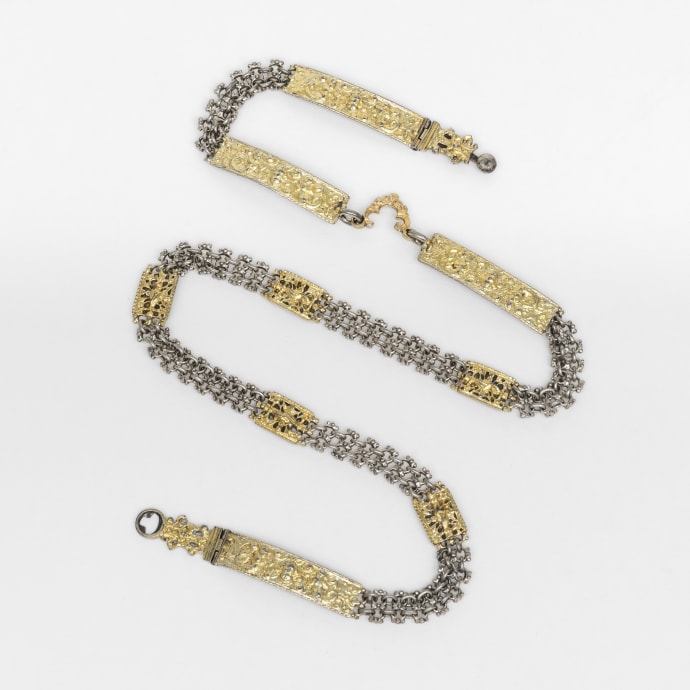







Description
Exceptional renaissance girdle belt, published and exhibited, likely owned by a woman
The belt consists of a silver chain with links composed of figure eights and clustered globules forming rosettes, interconnected with double loops. Four identical rectangular plaques cast in silver and gilded show a cherub’s head flanked by sirens and surrounded by scrolls. Two of the plaques with hook and loop form the clasp, and the other two are connected by an ornate trefoil hanger. Interspersed within the chain are five small openwork plaques cast in silver and gilded with identical relief motif: clasped right hands holding a heart pierced by arrows. A hallmark, repeated four times, can be identified as the silver hallmark for Laibach (today Slovenia, formerly Austro-Hungarian Empire) between 1806-1824 as proof of taxation paid for earlier made objects, see: Alfred Rohrwasser, Österreichs Punzen, Perchtoldsdorf 1987, p. 61 and 11.
Exhibited and Published:
Exh. cat. Van haarnaald tot schoengesp, Accessoires in goud en zilver, Deurne Zilvermuseum Sterckshof, 2011, no. 119.
Literature:
Girdles or belts like this Renaissance example were typically worn by both men and women to clinch their voluminous clothing. A hook or additional loop, such as the trefoil-shaped hanger that appears on the present girdle, functioned to hang keys, a purse, an amulet, or even a pomander (scent holder) from waist. Made in cloth with gold or gilt panels, or in silver, or with glass enamel, or sometimes entirely in gilded silver, like here, girdles survive in relatively large numbers from the Middle Ages and Renaissance, although they were frequently dismantled, the panels dispersed separately or reworked. The large circumference of our belt when it is fastened around the waist suggests that it was intended to be worn loose, as appears in Renaissance portraits.
There is evidence that this Renaissance girdle was once the property of a woman. In Boccaccio’s Decameron of c. 1349 to 1352, girdles along with other female accessories frequently appear as the property of women, found in their household chests. They were often given as dowry presents or as gifts to a young bride. They even figured in marriage ceremonies, as the symbolic unfastening of the bridegroom before retiring with the bride, or after the wedding night (Bernward Deneke, Hochzeit, Munich 1971, pp. 132-134; Jane Perry, Traditional Jewellery in the Nineteenth-Century Europe, London 2013, pp. 119-120, 30-32, 66-67). Worn as a protective amulet, they were thought to encourage fertility. On our belt the presence of the image of Cupid and the clasped right hands holding a heart, refer directly to the marriage vows, thus confirming its association with marriage. Ornamental prints by Renaissance artists, such as Virgil Solis (1514-1562), Theodor de Bry (1528-1598), to name but a few, served as inspirations for the designs.
The composition, type of chain, and imagery of girdles differed according to country and region. The same chain links appear on a belt in the Rijksmuseum, Amsterdam (inv. no. BK-1967-8) with similar rectangular plaques depicting cherubs. The Rijksmuseum belt is thought to have been made in the Netherlands, c. 1550-1600. Another belt with almost identical decoration comes from Denmark (ill., Fritze Lindahl, Skattefund, Danish Seventeenth-Century Silver Hoards, Copenhagen 1988, pp. 58, 142). For additional comparisons, see Karen Stolleis, Die Gewänder aus der Lauinger Fürstengruft. Mit einem Beitrag über Schmuckstücke von Irmtraud Himmelheber, Munich-Berlin 1977, pp126-129, cat. nos. 74 and 75; M.H. Gans, Juwelen en mensen, Schiedam 1979, fig. 161; Eva-Maria Lösel, Zürcher Goldschmiedekunst, Zurich 1983, pp. 442-447; Fritze Lindahl, Skattefund, Danish Seventeenth-Century Silver Hoards, Nationalmuseet, Copenhagen, 1988, pp. 50-65.
WOA-50466